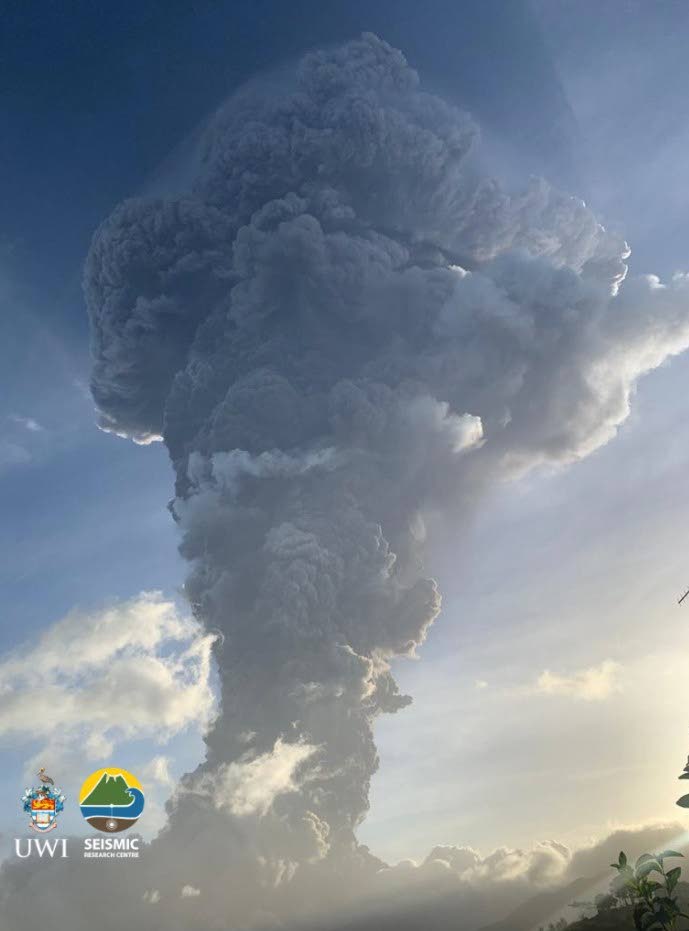World Bank gives preliminary $$ estimates for St Vincent recovery

PRIME Minister of St Vincent and the Grenadines Dr Ralph Gonsalves said the World Bank has given preliminary estimates of how much money would be needed for recovery efforts, once the activity of the La Soufriere volcano ceases. He stressed that none of the figures provided are final or official.
It has now been two weeks since the volcano's first eruption, which has been continuing. The most recent explosive eruption occurred at 11 am on Thursday, which was Earth Day.
In a live Facebook video on Thursday afternoon, some fishermen who were out at sea showed just how far out the material from the volcano was spreading.
One man said, "This goes to show everything Prof (Richard) Robertson has been saying is true because he did warn that the volcano could erupt again. And he said it could happen within a week."
Several areas in the northern parts of St Vincent – the red zone – are covered in ash. Most of the residents from these areas have since evacuated and are at the homes of family and friends or at the 80-plus shelters across the island.
Speaking at Wednesday morning’s virtual media update on the volcano’s activity, Gonsalves said many people have been asking him how much the damage will cost.
He said it is too early to give an estimate, but that “we have teams and we are working together to give preliminary estimates.”
He said in the red and orange (danger) zones surrounding the volcano, the assets at risk total US$387.5 million.
But he said, “It doesn’t mean that those assets at risk are going to be damaged to the extent of US$387.5 million.”
In the red zone, he said the replacement value of residential buildings at risk is US$64 million, US$106 million for non-residential buildings and US$83 million for infrastructure.
He said in areas being affected by pyroclastic flows, the capital stock at risk to buildings and infrastructure is US$188 million.
“So when I say that this is going to be hundreds of millions of Eastern Caribbean dollars, you will see that only in relation to risk to the buildings, infrastructure, agriculture and forestry, the World Bank is saying this is preliminary.
“That’s $300 million Eastern Caribbean dollars, but that doesn’t take into account of money you need to feed people, all the costs associated with the shelters, all the associated costs which will come now for the replanting of agriculture and forestry…Those are some of the numbers being crunched now, and they can only be rough estimates.”
He said the recovery of the country is going to take a very long time, adding that mudflow is expected to continue beyond 2022, “because not all the material is going to come down one time.
“So we are in for a pretty long haul.
“There are persons accustomed to instant coffee, Milo – instant chocolate, fast food like KFC or pizza…This is not going to be Milo…It ain’t going to be Nescafé, it not going to be fast food. Dis ya meat hard fi boil.”
Robertson, a vulcanologist and seismologist, said anything can happen at any given time regarding the volcano and urged the Vincentian public not to “drop their guard.
“Until this period where you have had a slight change plays out, I suggest that they stay out (of the red zone). Let’s see what happens before you think of doing that.”
Gonsalves said the security at the entrance to the red zone has “not been the tightest,” and so he spoke to the country’s commissioner of police, Colin John.
“Yesterday (Wednesday), it was decided that he would move the police officers who are at Mt Young Bridge and put them at Rabacca, because you have a number of people still in Georgetown, because it’s at the lower end of the red zone.”
Robertson said samples of the volcanic ash have been sent to Trinidad and Tobago and will then be sent to the UK for testing. In TT, he said, it will be “split up into different components.
“The initial analysis really is to see how much the ash has fresh material that has been same or different from before – remember, you sampled the dome. And also, very importantly, to see if there are any aspects of it that might be of concern in terms of health issues.”
Someone asked if it was possible for the volcano to become extinct. Robertson said yes, but it is showing “no such indication.”
He said over the past decades, there have been more dynamic explosive and non-explosive eruptions.
“I don’t think (the extinction) is happening in any of our lifetimes or our grandchildren’s lifetimes.”


Comments
"World Bank gives preliminary $$ estimates for St Vincent recovery"